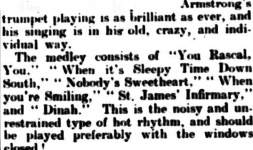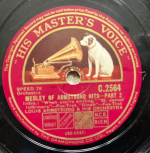The Clock Tower is a great place for a celebration. If you're there today, have a look around. Those buildings tell a lot of stories about the history of our club.
Look at this this photo from the 2016 parade. Let's start with the three buildings marked:
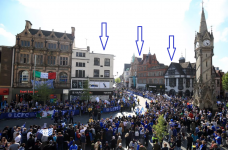
1) First the one on the right. You can see below that it used to be called the 'East Gates Coffee House'. In the early days of Leicester Fosse it was, in effect, the headquarters of the club:
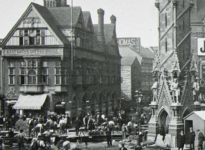
Back in the 1880s when Leicester Fosse played on Victoria Park there were, of course, no buildings at that site that belonged to the club. We were simply allocated an area of the park each week and we got on with it in front of a few dozen spectators, usually at the same time as a much larger crowd watched a rugby game on a neighbouring pitch.
The place where club members sat down to discuss selection and tactics was that coffee house by the Clock Tower. There would have been crisis meetings there too. There were times in those early days when the future of the club was in doubt, due to the lack of interest from local people and the difficulty in attracting players. But thankfully, they always found a way to keep the club going.
2) Next, the building just to the left. It's now the entrance to Highcross, but back in the 1930s, a new music and furniture store called Kingstone's opened there:
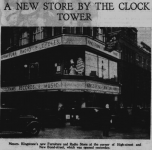
It's not the clearest photo, and if anyone knows of a better one, please post it below.
The mid-1930s was boom time for music stores, with the new gramophones taking off and sales of radios and records rocketing. There was fierce competition in the city centre, and the opening of Kingstone would not have been welcomed by Mr. Arthur Lochhead, manager of a music shop on nearby Loseby Lane. Lochhead was not in the shop every day becauase he had another job - he played inside-left for Leicester City. Later, after the death of Peter Hodge, he took over as boss at Filbert Street. The directors thought his experience running the shop would stand him in good stead.
When Kingstone opened, their Managing Director Charles Keene decided to get some extra publicity by arranging an instore appearance by a famous musician from America who was touring the UK. In February 1934, the tour arrived in Leicester. Jazz lovers packed out the Opera House in Silver Street, less than 50 yards from Kingstone, to see the sensational Louis Armstrong.
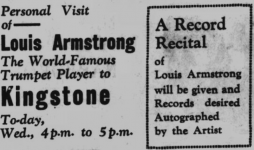
He played the Opera House for six nights, and as you can see, one afternoon that week he was at the store to sign autographs and do a 'record recital'. What does that mean? Did he just play some of his recent records? Did he sing along to them? Did he sing live without the records? Did he have his trumpet with him? I'm not sure. But what we do know is that one of his recent hits was a track called 'When You're Smiling'. Whether he performed it or not at Kingstone, it's very likely he performed it every night on stage.
What a time to be alive. The man who's been called 'the most important musician of the 20th century' blasting out an early version of our song right in the centre of town. And on the day he first took the stage at the Opera House, the draw for the FA Cup Quarter-Finals was held, giving Leicester City an away tie at Preston. We had never got beyond this stage before - but we won at Deepdale to take us into the semi-finals for the first time.
Louis Armstrong came back to Leicester twice after the War, and in 1959 we know for sure that 'When You're Smiling' was in his set. You might recall our old friend Bernie Henson trying to get Louis' autograph at the De Montfort Hall that night
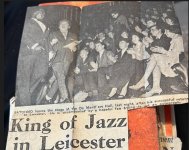
3) Now let's go back to the photo from 2016 and have a look at the building marked on the left:
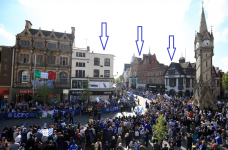
Leicester City fans used to spend a lot of time in that building, or to be precise, queueing up outside.
Why? Spot the clue on the wall:
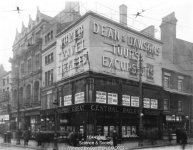
Dean and Dawson's travel agents was the place in the city centre that sold tickets for Leicester City, and before FA Cup matches like those in 1934, this would be the scene:
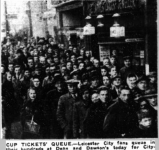
That was before our Fourth Round replay against Brentford in 1948.
4) If jazz was the in-thing in the 1930s, in the 1950s it was another import from America.
We know the precise moment that Rock'n' Roll mania hit Leicester. It was September 4th 1956. That evening, the film Rock Around The Clock was being shown at the Gaumont in the Market Place, and after reports of riotous scenes at showings in London, police were actually stationed inside the cinema.
But that didn't stop people. As the Evening Mail reported, 'Teenagers crocodiled down the aisles, and several times the soundtrack was stopped to prevent the patrons getting out of control'. Then after the film 'they crocodiled round the Clock Tower'.
In the days that followed there was pantomime outrage in the local papers, with calls to ban not just the film but all rock'n'roll music.
Something else was just beginning at that time - Leicester City's surge up the Second Division that took us to the top of the table, and ultimately the title. Those two timelines of excitement - in music and football - went totally hand in hand that season, with the hits of the day being transformed into terrace anthems. That promotion story will be told in detail in a forthcoming thread.
5) On the Clock Tower itself, looking down disapprovingly on those out of control teenagers in 1956, were the following:
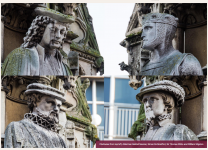
a) Alderman Newton, whose money helped set up the school in St. Martins under the playground of which King Richard III's body was discovered.
b) Simon de Montfort, whose Hall we mentioned above.
c) William Wyggeston - most of the early Fosse members who met at that Coffee House were former pupils of the school that took his name.
d) Thomas White, known as a 'civic benefactor'; his money helping out a number of local organizations. Which puts him in the same bracket as...
6) If the players on the balcony this afternoon look down to the left, they'll see the sporting statue. The story behind its installation is pretty familiar. Leicestershire won the County Championship in 1996, then the following year we won the League Cup and Tigers won the Pilkington Cup.
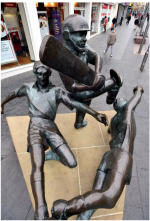
Does anyone know if the City player was based on anyone? Or is it just a generic footballer?
It was Steve Claridge's goal in the replay that won us the Cup, four days after a 1-1 draw at Wembley. That match was a milestone in the life of Vichai Raksriaksorn, as he was then known. It was the first time he'd watched a football match in England. After that, well, he had that dream.
Please add any other Clock Tower related stories. There must be others.
Look at this this photo from the 2016 parade. Let's start with the three buildings marked:

1) First the one on the right. You can see below that it used to be called the 'East Gates Coffee House'. In the early days of Leicester Fosse it was, in effect, the headquarters of the club:

Back in the 1880s when Leicester Fosse played on Victoria Park there were, of course, no buildings at that site that belonged to the club. We were simply allocated an area of the park each week and we got on with it in front of a few dozen spectators, usually at the same time as a much larger crowd watched a rugby game on a neighbouring pitch.
The place where club members sat down to discuss selection and tactics was that coffee house by the Clock Tower. There would have been crisis meetings there too. There were times in those early days when the future of the club was in doubt, due to the lack of interest from local people and the difficulty in attracting players. But thankfully, they always found a way to keep the club going.
2) Next, the building just to the left. It's now the entrance to Highcross, but back in the 1930s, a new music and furniture store called Kingstone's opened there:

It's not the clearest photo, and if anyone knows of a better one, please post it below.
The mid-1930s was boom time for music stores, with the new gramophones taking off and sales of radios and records rocketing. There was fierce competition in the city centre, and the opening of Kingstone would not have been welcomed by Mr. Arthur Lochhead, manager of a music shop on nearby Loseby Lane. Lochhead was not in the shop every day becauase he had another job - he played inside-left for Leicester City. Later, after the death of Peter Hodge, he took over as boss at Filbert Street. The directors thought his experience running the shop would stand him in good stead.
When Kingstone opened, their Managing Director Charles Keene decided to get some extra publicity by arranging an instore appearance by a famous musician from America who was touring the UK. In February 1934, the tour arrived in Leicester. Jazz lovers packed out the Opera House in Silver Street, less than 50 yards from Kingstone, to see the sensational Louis Armstrong.

He played the Opera House for six nights, and as you can see, one afternoon that week he was at the store to sign autographs and do a 'record recital'. What does that mean? Did he just play some of his recent records? Did he sing along to them? Did he sing live without the records? Did he have his trumpet with him? I'm not sure. But what we do know is that one of his recent hits was a track called 'When You're Smiling'. Whether he performed it or not at Kingstone, it's very likely he performed it every night on stage.
What a time to be alive. The man who's been called 'the most important musician of the 20th century' blasting out an early version of our song right in the centre of town. And on the day he first took the stage at the Opera House, the draw for the FA Cup Quarter-Finals was held, giving Leicester City an away tie at Preston. We had never got beyond this stage before - but we won at Deepdale to take us into the semi-finals for the first time.
Louis Armstrong came back to Leicester twice after the War, and in 1959 we know for sure that 'When You're Smiling' was in his set. You might recall our old friend Bernie Henson trying to get Louis' autograph at the De Montfort Hall that night

3) Now let's go back to the photo from 2016 and have a look at the building marked on the left:

Leicester City fans used to spend a lot of time in that building, or to be precise, queueing up outside.
Why? Spot the clue on the wall:

Dean and Dawson's travel agents was the place in the city centre that sold tickets for Leicester City, and before FA Cup matches like those in 1934, this would be the scene:

That was before our Fourth Round replay against Brentford in 1948.
4) If jazz was the in-thing in the 1930s, in the 1950s it was another import from America.
We know the precise moment that Rock'n' Roll mania hit Leicester. It was September 4th 1956. That evening, the film Rock Around The Clock was being shown at the Gaumont in the Market Place, and after reports of riotous scenes at showings in London, police were actually stationed inside the cinema.
But that didn't stop people. As the Evening Mail reported, 'Teenagers crocodiled down the aisles, and several times the soundtrack was stopped to prevent the patrons getting out of control'. Then after the film 'they crocodiled round the Clock Tower'.
In the days that followed there was pantomime outrage in the local papers, with calls to ban not just the film but all rock'n'roll music.
Something else was just beginning at that time - Leicester City's surge up the Second Division that took us to the top of the table, and ultimately the title. Those two timelines of excitement - in music and football - went totally hand in hand that season, with the hits of the day being transformed into terrace anthems. That promotion story will be told in detail in a forthcoming thread.
5) On the Clock Tower itself, looking down disapprovingly on those out of control teenagers in 1956, were the following:

a) Alderman Newton, whose money helped set up the school in St. Martins under the playground of which King Richard III's body was discovered.
b) Simon de Montfort, whose Hall we mentioned above.
c) William Wyggeston - most of the early Fosse members who met at that Coffee House were former pupils of the school that took his name.
d) Thomas White, known as a 'civic benefactor'; his money helping out a number of local organizations. Which puts him in the same bracket as...
6) If the players on the balcony this afternoon look down to the left, they'll see the sporting statue. The story behind its installation is pretty familiar. Leicestershire won the County Championship in 1996, then the following year we won the League Cup and Tigers won the Pilkington Cup.

Does anyone know if the City player was based on anyone? Or is it just a generic footballer?
It was Steve Claridge's goal in the replay that won us the Cup, four days after a 1-1 draw at Wembley. That match was a milestone in the life of Vichai Raksriaksorn, as he was then known. It was the first time he'd watched a football match in England. After that, well, he had that dream.
Please add any other Clock Tower related stories. There must be others.
Last edited:

